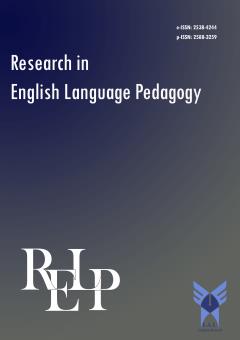The Relationship Among Identity Aspects, Brain-Friendly Instruction, and Iranian IELTS Candidates' Performance in Speaking and Reading Subcomponents
Subject Areas : Research in English Language Pedagogy
Abdolhamid Mohamadi
1
,
Seyyed Ayatollah Razmjoo
2
,
Shahram Afraz
3
![]() ,
Fazlolah Samimi
4
,
Fazlolah Samimi
4
1 -
2 - Faculty of Foreign Languages, Shiraz University, Shiraz, Iran
3 -
4 -
Keywords: Identity, Brain-Friendly Instruction (BFI), Language Proficiency,
Abstract :
This research looks at how identity aspects, knowledge of Brain-Friendly Instruction (BFI), and speaking and reading parts are related to Iranian EFL students getting ready for the IELTS test. The study included 206 upper-intermediate IELTS candidates from Bandar Abbas chosen through purposive sampling. Researchers collected data using the Aspects of Identity Questionnaire (AIQ-IV), a BFI awareness scale, and practice IELTS Reading and Speaking tests. Three qualified raters checked the speaking tests. The tests' reliability was confirmed with a Cronbach's alpha of .851. Researchers used multiple regression analysis with SPSS version 25 to explore how well identity aspects (personal, social, collective, relational) and BFI components (instruction, motivation assessment) predicted IELTS speaking and reading parts. The results showed that social identity and motivation helped predict fluency and coherence in speaking, while instruction and collective identity were key for grammatical range and accuracy. For reading, motivation and instruction predicted identifying information, while the collective part of identity helped predict understanding the main idea. These results suggest that identity and BFI components play key roles in shaping language skills in speaking and reading for Iranian EFL learners. The study's results have important pedagogical implications, emphasizing the need for tailored instructional strategies that consider learners' identity and cognitive needs. Future research could further explore these relationships in diverse cultural contexts to validate and extend these findings.
Cheek, J. M., Smith, S., & Tropp, L. R. (2002). Relational identity orientation: A fourth scale for the AIQ.
Darvin, R., & Norton, B. (2019). *Identity, language learning, and the digital world.* In S. M. Mercer, Z. Dornyei, & A. M. Ryan (Eds.), Language Learning Psychology (pp. 47-64). Palgrave Macmillan.
Dörnyei, Z., & Ushioda, E. (2020). Teaching and researching motivation. Routledge.
Ellis, R. (2018). Understanding second language acquisition. Oxford University Press.
Erler, L., & Macaro, E. (2019). Learning strategies in foreign and second language classrooms: The role of learner strategies. Language Teaching, 52(4), 461-479.
Esfandiari, R., & Ahmadi, E. (2022). The impact of Brain-Friendly Instruction on Iranian EFL learners’ speaking skills: A quasi-experimental study. Journal of English Language Teaching and Learning, 12(3), 75-92.
Gao, Y., Zhao, Y., Cheng, Y., & Zhou, Y. (2020). Collective identity and EFL learning: The case of Chinese learners. Journal of Language and Social Psychology, 39(5), 521-533.
Ghahari, S., & Basanjideh, M. (2015). The role of motivational strategies in language teaching: A study on Iranian EFL teachers' practices. Journal of Language Teaching and Research, 6(4), 781-791. https://doi.org/10.17507/jltr.0604.09
Grabe, W., & Stoller, F. L. (2013). Teaching and researching reading. Routledge.
Graham, S., Macaro, E., & Vanderplank, R. (2020). Language learner strategies: 30 years of research and practice. Oxford University Press.
IELTS. (2021). IELTS Speaking: Assessment criteria. IELTS Official Website.
Jensen, E. (2008). Brain-based learning: The new paradigm of teaching. Corwin Press.
Kim, Y. Y. (2020). Personal identity and second language acquisition. John Benjamins Publishing.
Lubliner, S., & Smetana, L. (2020). Reading comprehension and critical thinking: Fostering comprehension in the elementary classroom. Guilford Press.
Mahmoodi, M., & Dehghani, M. (2020). Exploring the role of identity in Iranian EFL learners’ willingness to communicate: A sociocultural perspective. Iranian Journal of Applied Language Studies, 12(1), 123-144.
McCulloch, S. (2019). Identity in language learning and teaching: A critical review. Bloomsbury Publishing.
Mehri, Y., Salari, S. M., Langroudi, M. S., & Baharamizadeh, H. (2011). The relationship between differentiation of self and aspects of identity. Procedia Social and Behavioral Sciences, 30, 733-737.
Mercer, S. (2019). Language learner psychology: A critical perspective. Second Language Research, 35(2), 145-161.
Nematizadeh, S., Ahmadian, M. J., & Tavakoli, M. (2019). The impact of identity on L2 learning among Iranian EFL learners. Applied Linguistics Review, 10(3), 457-479.
Norton, B. (2013). Identity and language learning: Extending the conversation. Multilingual Matters.
Norton, B. (2021). Identity and language learning: Extending the conversation. Multilingual Matters.
Rahimi, M., & Katal, M. (2018). Identity and language learning in Iran: A review of literature. Iranian Journal of Language Teaching Research, 6(3), 45-63.
Ranjbar, R., & Abdollahi, S. (2021). The effectiveness of Brain-Friendly Instruction on enhancing Iranian high school students' English reading comprehension. Journal of Educational Psychology Studies, 16(2), 45-67.
Riazi, A., & Rahimi, M. (2019). Language learning motivation and identity among Iranian IELTS candidates: The mediating role of Brain-Friendly Instruction. Language Teaching Research, 23(4), 517-533.
Sattari Gavareshk, E., & Tabatabaee-Yazdi, M. (2022). A Brain-Friendly Teaching Inventory: A Rasch-based Model Validation. Journal of English Language Pedagogy and Practice, 14(29),100-120. https://doi.org/10.30495/jal.2022.690038
Sousa, D. A. (2018). How the brain learns (5th ed.). Corwin Press.


